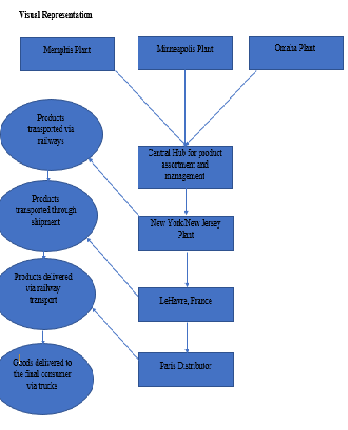National Appliance Inc Logistics Case Analysis
According to Marchet, Melacini, Perotti, & Tappia (2016), correlations exist between organizational internationalization choices and logistics operations. Expressly, the authors point out that logistics serve as crucial enablers for company internationalization, which further contributes to a significant increase in logistics network complexity. Today, society is characterized by an increased demand for flexibility and speed, which require organizations to understand that their logistics strategy serves as a vital aspect of the overall operations and further contributes to achieving corporate objectives (Marchet, Melacini, Perotti, & Tappia, 2016).
In this case, National Appliance Inc has been operational for the past 35 years. During the past 15 years, they have experienced increased growth in their share of the products due to the provision of high-quality products at lower prices. This growth has been coupled with vertical integration in the company’s supply and marketing channels. Nonetheless, the company’s expansion into an international market, Paris, is characterized by various strengths and limitations, especially in logistics planning.
More precisely, the strengths associated with Mr. Reard’s international transportation plan include vast experience and considerable expertise in domestic transport management and logistics. These essential components have been acquired through the company’s successful transportation of their products domestically for the past 15 years, contributing to a significant reduction of transportation costs (Li & Sun, 2014).
Additionally, the plan formulated by Mr. Reard portrays strength based on the control and close monitoring of transportation activities via trucks, which allow him to remain in close contact with the drivers. As a result, this strategy fosters increased flexibility in services and the employment rate for many drivers. Besides, potential delays in truck transportation can be quickly addressed than other modes of transportation. Simultaneously, shipment of goods internationally from New Jersey to LeHavre, France, could significantly reduce transportation costs for the company compared to airplanes (Cook, 2016).
Conversely, Mr. Reard’s plan is characterized by several weaknesses that include a considerable distance between the United States and Paris. If the products are transported via shipping, they will take at least four weeks to reach the destination. As a result, the costs incurred during this period would significantly increase the lead times, ultimately affecting its price. Specifically, transportation of the finished products from the different plants, Memphis, Minneapolis, and Omaha, would significantly increase the costs and contribute to long lead times (Cook, 2016).
Besides, hiring an international transportation manager to take charge of Paris operations would lead to increased costs as he/she would demand a high salary. These shortcomings are coupled with the fact that Mr. Reard and his staff lack the necessary international experience and may thus be ill-equipped to prepare the plan.
An alternative plan that should be presented to Ms. Jameson entails:
- Establishing a central hub between the three plants to facilitate management and assortment of the products and direct dispatched to New Jersey port to minimize the transportation costs and ensuring quality
- Use rail transportation as the most reliable, timely, less costly, and risky mode in Europe for bulk products
- Shift to shipment of the products from New Jersey to LeHavre, France, coupled with the relevant insurance before dispatching of the goods
- Avoid hiring a transportation manager since it is not elaborately established whether doing business with the Paris distributor is on a contractual or regular basis
- Engagement management in laying out the operational terms between the Paris distributor and National Appliance Inc
Visual Representation

National Appliance Inc Logistics Case Analysis Conclusion
As a justification for the strategy applied in Mr. Reard’s case, the international transportation plan formulated above focuses on cost reduction and the maintenance of quality and timely delivery of the company products to the end-user. Essentially, the central hub established will play a pivotal role in ensuring accuracy through the assortment and management of the products before they are dispatched to the New Jersey/New York plant.
This way, the lead time will be significantly reduced, and the goods meant for transportation to Paris will be readily available, fostering timely delivery to the final consumer. Nevertheless, this strategy harbors some shortcomings based on risks and losses associated with railway transportation. Additionally, in case of potential delays, accidents, or power outages, monitoring the transportation of goods becomes a challenge and can deter other sectors of the logistics and transportation process. Contrastingly, using trucks to transport goods may be effective but take more time.
References
Cook, T. A. (2016). Managing growth and expansion into global markets: logistics, transportation, and distribution. CRC Press.
Li, X., & Sun, X. (2014). Operations Management of Logistics and Supply Chain: Issues and Directions. Discrete Dynamics in Nature and Society. https://doi.org/10.1155/2014/701938
Marchet, G., Melacini, M., Perotti, S., & Tappia, E. (2016). Shaping the international logistics strategy in the internationalisation process. International Journal of Supply Chain and Operations Resilience, 2(1), 72. https://doi.org/10.1504/ijscor.2016.075914
Place your order on Best Essay Writers

